Scratch The Gnat Original Design / Scratch Built
Scratch - The Gnat {Scratch}
Contributed by Geof Givens
| Manufacturer: | Scratch |
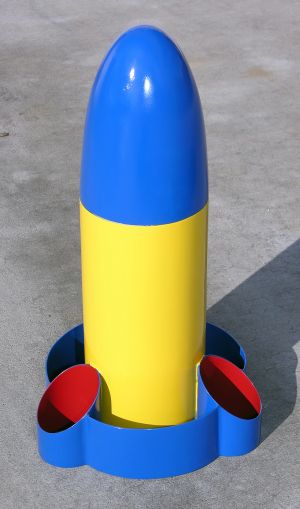
Brief:
The Gnat is a 5" diameter stubby rocket for 29mm motors that I built mainly out of leftover household items and
a few rocket scraps. It is 17.5in tall and weighs 29oz. It is my latest creation in my ongoing love affair/obsession
with the original Estes Fat Boy and other stubby rockets. A RockSim file is provided. This uses a stubby rocket
correction element and adjustments for ring fins and tube fins following the expert suggestions of Bob Cox, but I take
all responsibility for flaws in the file (of which there are probably many!)
Construction:
The body was constructed from two empty cans of Tang--every astronaut's favorite orange drink. The rocket's name was
chosen as an anagram of TANG. I removed the metal bottoms and rim, then used 10.5 inches (in two sections) for the body
tube, and the remaining portion as a tube coupler, a strengthening ring in the forward interior portion of the body,
the ring fin, and a shoulder ring for the nose cone. Over this I laid two layers of 6oz fiberglass, then many coats of
Kilz until it could be sanded smooth and primed.
Scrap plywood was used for centering rings, and an eye bolt was attached to the forward ring for the shock cord. The rear ring got two T-nuts installed for later use with some small bolts and clips for positive motor retention. The motor tube was 29mm.
The nose cone began as some blocks of green foam used for floral arrangements. See this featured tip for a detailed description of the process. I glued four blocks together with yellow glue. Next, I used my 2" hole-driller bit to drill a hole the size of the bit in the approximate center of the block. Then I covered the bit with masking tape and epoxied it right into the hole. Next, I mounted the bit in my drill and mounted the drill in my vise. Using 150 grit sandpaper, I fashioned a cone in the style of a Fat Boy. WARNING: if you try this, be aware that you and everything in the garage will become covered in green foam dust. My face was unrecognizable when I finished, and I was so covered with green dust that my kids named me the green snowman.
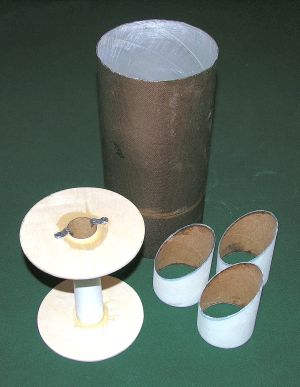 On top of the foam I laid two layers of 6oz fiberglass. It was very difficult to get the glass to lay
smoothly on this shape cone. For each layer, I used 4 parabolic leaves with a vertical notch taken out of each leaf so
that it would narrow correctly toward the nose. The two layers of leaves were staggered by 45 degrees. To get it
smooth, I used Kilz and then Elmer's Wood Filler and many repetitions of fill, sand, prime, fill, sand, prime. Finally
the cone looked smooth.
On top of the foam I laid two layers of 6oz fiberglass. It was very difficult to get the glass to lay
smoothly on this shape cone. For each layer, I used 4 parabolic leaves with a vertical notch taken out of each leaf so
that it would narrow correctly toward the nose. The two layers of leaves were staggered by 45 degrees. To get it
smooth, I used Kilz and then Elmer's Wood Filler and many repetitions of fill, sand, prime, fill, sand, prime. Finally
the cone looked smooth.
Some of my Tang can was epoxied to the foam shoulder of the nose cone to provide a smooth, firm, round shoulder. Then I yanked out the drill bit and cleaned it off. About 3.5 oz of nose weight was necessary, epoxied all the way up at the underside of the nose tip. To this point, I epoxied lead weights. Then on the inside of the nose cone shoulder, I sanded away about 1/4in of foam across the whole surface, so that I could lay in a circular plywood bulkhead with an eye bolt in it for the shock cord. I gave this bulkhead a strong fillet to join it to the interior side of the nose cone shoulder.
From a short scrap piece of BT-80 tubing I bevel cut the three tube fins. These got the standard 2 layers 6oz fiberglass, Kilz, filler, and priming. These were epoxied and filleted onto the main body.
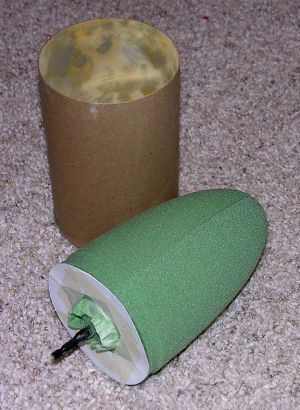 The ring fin was more difficult. In fact, I had to drink up more Tang because I wasn't satisfied with my
first attempt. I began by cutting portions that were slightly longer than would be needed. Having marked the points of
attachment on each tube fin, I carefully positioned the cut piece directly behind the tube fins and flexed it to the
correct arc to mark the exact length needed for the desired curve. Because of slight irregularities in positioning and
angles, the three ring fin portions ended up slightly different lengths and had to be carefully labeled to avoid
confusion.
The ring fin was more difficult. In fact, I had to drink up more Tang because I wasn't satisfied with my
first attempt. I began by cutting portions that were slightly longer than would be needed. Having marked the points of
attachment on each tube fin, I carefully positioned the cut piece directly behind the tube fins and flexed it to the
correct arc to mark the exact length needed for the desired curve. Because of slight irregularities in positioning and
angles, the three ring fin portions ended up slightly different lengths and had to be carefully labeled to avoid
confusion.
These ring fin portions came from a 5in diameter can but needed to be shaped to a ring of wider diameter. To do this, I used CA glue and balsa to attach a bracing structure in the inside of the ring portion, stretching/bending the ring to the correct arc. Now I could put two layers of fiberglass on the ring. After it cured, I removed the braces and the ring was permanently shaped correctly. More filling, sanding, priming followed. Finally, the ring fin portions were epoxied in place and filleted on both sides.
The parachute was an elliptical X-form of the Vatsaas design made from gray rip stop nylon. It was my first attempt at sewing (my wife got tired of sewing my chutes), and it worked well.
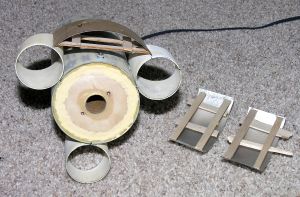
Finishing:
The paint job was done carefully, allowing ample drying time between colors to prevent pulling away paint layers. A
lot of tricky masking was required. It looked so good that I decided to skip some planned wavy blue patterns where the
nose meets the body. I was afraid of spoiling a good effort.
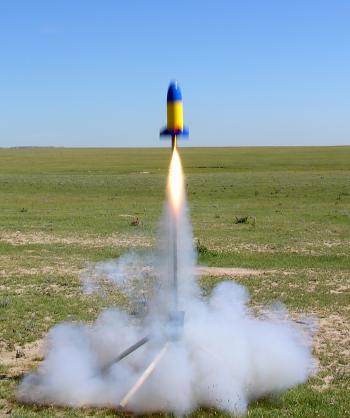 Flight:
Flight:
The first flight was on a G64-4W which enabled the Gnat to climb nimbly on my 6 foot rail. Winds were strong and
buffeting at 15mph or more, but the Gnat flew true after some brief weathercocking off the rail. This rocket is
absolutely stable and apparently strongly so. Altitude was modest, certainly less than 1000ft. The 4 second delay was
about right in these conditions.
Recovery:
With the brisk winds and slightly undersized X-form chute, descent was much too swift. A portion of the fin assembly
separated on impact but there was no structural damage to any parts. I plan to epoxy it back together, redo the paint,
and fly it again.
Summary:
The pros of this project were cool stubby design, ring and tube fins, and lots of opportunities to learn about
fiberglassing. One important con is that the tube fins do not have any through-the-wall mounting, and I paid for this
on the hard landing. I'll need to use a larger chute next time.
 |
 |